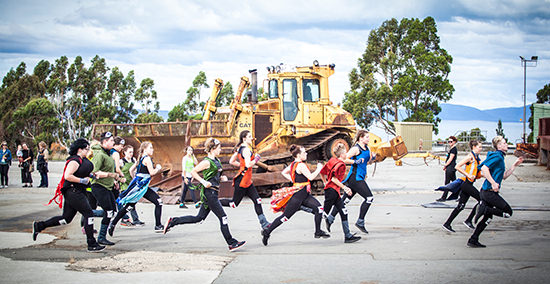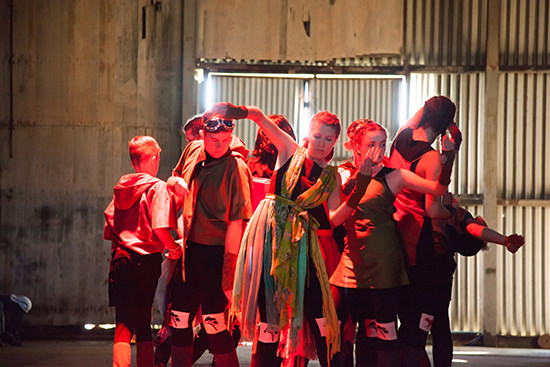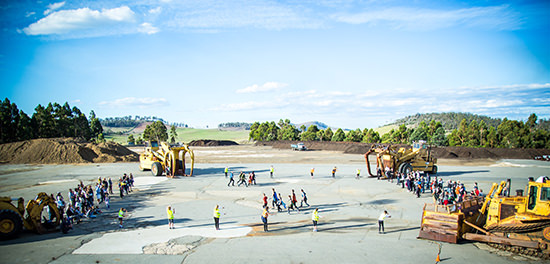Regional industry: dance versus loss
Judith Abell: Stompin, Panorama

Stompin’s Panorama at the Spring Bay Mill
photo Jasper Da Seymour
Stompin’s Panorama at the Spring Bay Mill
We are standing on contested property, clustering on an exposed headland looking to Maria Island in the east and the small Tasmanian towns of Triabunna and Orford to the south and north. We are within the grounds of the large, decommissioned Spring Bay woodchip mill. We pause, the voices of local young people in our ears, as the dancers of Stompin and young performers from Triabunna fill the semi-circular embrace of this remnant industrial structure. They raise their arms up and outwards. They look up. They flick their wrists back and forth. They cup their palms. Taking in this extraordinary view, we are experiencing Stompin’s Panorama.
Throughout Tasmania, small towns, often within astonishing landscapes, are experiencing change as the state shifts away from primary industry to secondary and tertiary forms. Many consider this to be a positive, sustainable change, but the residents of small communities like Triabunna feel the transition directly through threatened salaries, dislocation of their families, loss of local businesses and the consequent disappearance of life within their towns. Triabunna’s mill was closed in 2011 and then sold to private developers, instigating a lengthy period of limbo while plans evolve for new uses. This is fertile ground for Stompin, a Launceston-based youth dance company focused on issues relevant to young Tasmanians. The company worked directly with the townspeople to create Panorama, which leads an audience to several locations within the mill. The issues presented mix local concerns with wider interests and fears held for young people.
The work is divided into three parts. In the first, the audience splits into two groups and each led by a local child throughout the site. All of us wear tuned headphones that pick up a transmitted soundscape. The initial dance episode, as described above, happens at the walk’s mid-point within a concrete structure. Small solo or paired dance vignettes occur as we complete the site loop. The second act takes place on the spacious plateau just beyond the entry to the site, with dance formations bookended by large earthmovers, their giant claws made for log movement. The final act takes place within one of the mill’s industrial buildings, its steel cladding offering a percussive surface for the performers.
Dancers are costumed to represent different roles and interests. They are mill workers, they are tradies, they are environmentalists, they are high-vis-clad bystanders. Within the lexicon of Panorama’s choreographic language there appear to be representations of trees, the organic lines of the local landscape, the muscular language of workers and the line of the horizon, underscored by continuous movements back and forth—a macro theme of ebb and flow. A particularly successful sequence within the mill building sees the dancers moving as though parts of a machine, their piston-like action underscoring the theme.

Stompin’s Panorama at the Spring Bay Mill
photo Jasper Da Seymour
Stompin’s Panorama at the Spring Bay Mill
The soundscape components by sound designer Dylan Sheridan and sound artist Alisdair Macindoe comprise the strongest dimension of Panorama. They draw together local voices and sounds, often using field recordings as the basis for rhythmic sequences or establishing the sense of change. The compositions establish the emotional tenor of the work, ranging from an angry industrial feel to sweeter, anthemic sounds that cast a sense of optimism over the final sequences of the show. I particularly enjoy a section that uses the thump of large machinery as the rhythm for the dance.
The use of headphones is very smoothly managed in the first section of the show and is so successful in creating intimacy and connection and reducing the problems of sound projection within a vast landscape that I wonder why it wasn’t used more extensively as a soundtrack for all the movement sequences. When the dance later kicked in, the transmitted soundscape dropped away and external speakers took over—a missed opportunity.
In an increasingly unsupportive environment for the arts within Australia, Stompin must be applauded for continuing to take on challenging sites and situations. This show is no exception, contending with an unsettled town, a languishing industrial site and the ghosts of a politically charged situation. To this Stompin brings empathetic commitment, engaging locals for the show as storytellers, performers, volunteers and audience members. The site becomes a strong player in the work and the soundscape connects all of the pieces (introduced prior to the visit with a podcast). Yet amid these challenges of production it seemed as though the dance received less attention, particularly those sections performed outside and incorporating local performers. While it is obviously quite challenging to work in this context, building more complexity and breadth into the movement could have helped pull the choreography into line with stronger elements of Panorama.

Stompin’s Panorama at the Spring Bay Mill
photo Jasper Da Seymour
Stompin’s Panorama at the Spring Bay Mill
Stompin, Panorama, director, choreographer Emma Porteus, guest choreographer, sound artist Alisdair Macindoe, lighting, spatial designer Matthew Adey, sound designer Dylan Sheridan, costume designer Bones Sylvan; Spring Bay Mill, Triabunna, Tasmania, 8-10 April
RealTime issue #132 April-May 2016, web






